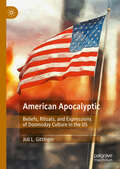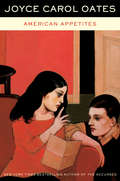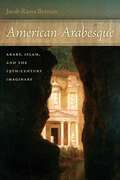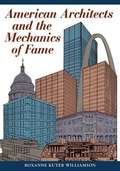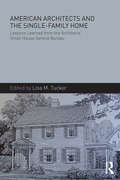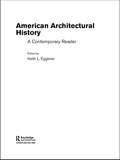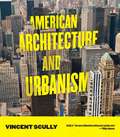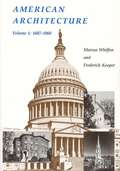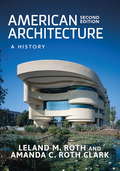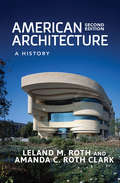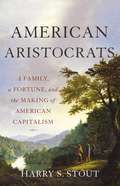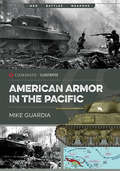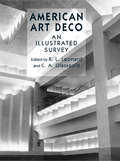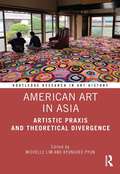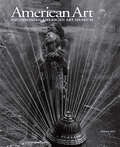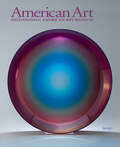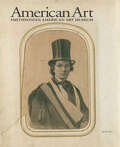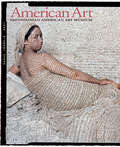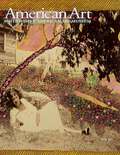- Table View
- List View
American Apocalypse: The Six Far-Right Groups Waging War on Democracy
by Rena SteinzorA thorough analysis of the right-wing interests contributing to the downfall of American democracy The war on American democracy is at a fever pitch. Such a corrosive state of affairs did not arise spontaneously up from the people but instead was pushed, top-down, by six private sector special interest groups—big business, the House Freedom Caucus, the Federalist Society, Fox News, white evangelicals, and armed militias. In American Apocalypse Rena Steinzor argues that these groups are nothing more than well-financed armies fighting a battle of attrition against the national government, with power, money, and fame as their central motivations. The book begins at the end of Lyndon Johnson's presidency, when the modern regulatory state was born. Agencies like the Environmental Protection Agency and the Food and Drug Administration ensured that everything from our air to our medicine was safe. But efforts to thwart this "big government" agenda began swiftly, albeit in the shadows. Business leaders built a multi-billion dollar presence in the Capitol, and the rest of the six interest groups soon followed. While the groups do not coordinate their attacks, and sometimes their short-term goals even conflict, their priorities fall within a surprisingly tight bullseye: the size and power of the administrative state. In the near-term, their campaigns will bring the crucial functions of government to a halt, which will lead to immediate suffering by the working classes, and a rapid deterioration of race relations. Over the long-term, as the prevalence of global pandemics and climate crises increase, an incapacitated national government will usher in unimaginable harm. This book is the first to conceptualize these groups together, as one deconstructive and awe-inspiring force. Steinzor delves into each of their histories, mapping the strategies, tactics, and characteristics that make them so powerful. She offers the most comprehensive story available about the downfall of American democracy, reminding us that only by recognizing what we are up against can we hope to bring about change.
American Apocalyptic: Beliefs, Rituals, and Expressions of Doomsday Culture in the US
by Juli L. GittingerIn this book, Juli Gittinger argues that America’s fascination (obsession?) with the apocalypse is a synthesis of religion, popular culture, and politics in a way that is particular to the US and consonant with mythological-historical narratives of America. As a result, we can identify American apocalypticism as a sort of religion in itself that is closely tied to “civil religion,” that has a worldview and rituals that create identifiable communities and connects American mythology to apocalyptic anxieties. Gittinger discusses how various cultures and groups form as a result of this obsession, and that these communities form their own rituals and responses in various forms of “prepping” or survivalist practices. She lays out an argument for a broad eschatology prevalent in the US that extends beyond traditional religious designations to form an apocalyptic worldview that is built into our narrative as a country, as well as furthered by popular culture and media’s contributionto apocalyptic anxieties. Subsequently, Gittinger uses case studies of apocalyptic events—current or speculative—that reveal how our anxieties about the end of the world (as we know it) inform our culture, as well as religious narratives that emerge from such crises.
American Appetites
by Joyce Carol OatesFor twenty-six years, Ian McCullough, a demographics researcher at a social science think tank, has been happily married to Glynnis, a successful cookbook writer and a brilliant hostess.When a drunken argument about a suspected infidelity turns physical, Ian accidentally pushes Glynnis through a plate-glass window--or did she fall? Now, Glynnis is dead, Ian is charged with murder, and their American dream is shattered. And soon, in a courtroom where guilt and responsibility become two very separate issues, Ian will stand trial, fighting for his life.A sophisticated, witty, and chilling novel from the incomparable Joyce Carol Oates, American Appetites explores our insatiable hunger for power, love, and success, and how comfortable, privileged lives--and the course of fate--can be dramatically transformed in an instant. fate--can be dramatically transformed in an instant.
American Arabesque: Arabs and Islam in the Nineteenth Century Imaginary (America and the Long 19th Century #11)
by Jacob Rama BermanPart of the American Literatures Initiative Series American Arabesque examines representations of Arabs, Islam and the Near East in nineteenth-century American culture, arguing that these representations play a significant role in the development of American national identity over the century, revealing largely unexplored exchanges between these two cultural traditions that will alter how we understand themtoday.Moving from the period of America's engagement in theBarbary Wars through the Holy Land travel mania in the years of Jacksonian expansion and into the writings of romantics such as Edgar Allen Poe, the book argues that not only were Arabs and Muslims prominently featured in nineteenth-century literature, but that the differences writers established between figures such as Moors, Bedouins, Turks and Orientals provide proof of the transnational scope of domestic racial politics. Drawing on both English and Arabic language sources, Berman contends that the fluidity and instabilityof the term Arab as it appears in captivity narratives, travel narratives,imaginative literature, and ethnic literature simultaneously instantiate and undermine definitions of the American nation and American citizenship.
American Architects and the Mechanics of Fame
by Roxanne Ruter WilliamsonWhy does one talented individual win lasting recognition in a particular field, while another equally talented person does not? While there are many possible reasons, one obvious answer is that something more than talent is requisite to produce fame. The "something more" in the field of architecture, asserts Roxanne Williamson, is the association with a "famous" architect at the moment he or she first receives major publicity or designs the building for which he or she will eventually be celebrated. In this study of more than six hundred American architects who have achieved a place in architectural histories, Williamson finds that only a small minority do not fit the "right person–right time" pattern. She traces the apprenticeship connection in case studies of Louis Sullivan, Frank Lloyd Wright, Henry Hobson Richardson, the firm of McKim, Mead & White, Latrobe and his descendants, the Bulfinch and Renwick Lines, the European immigrant masters, and Louis Kahn. Although she acknowledges and discusses the importance of family connections, the right schools, self-promotion, scholarships, design competition awards, and promotion by important journals, Williamson maintains that the apprenticeship connection is the single most important predictor of architectural fame. She offers the intriguing hypothesis that what is transferred in the relationship is not a particular style or approach but rather the courage and self-confidence to be true to one's own vision. Perhaps, she says, this is the case in all the arts. American Architects and the Mechanics of Fame is sure to provoke thought and comment in architecture and other creative fields.
American Architects and the Single-Family Home: Lessons Learned from the Architects' Small House Service Bureau
by Lisa M. TuckerAmerican Architects and the Single-Family Home explains how a small group of architects started the Architects’ Small House Service Bureau in 1919 and changed the course of twentieth-century residential design for the better. Concepts and principles they developed related to public spaces, private spaces, and service spaces for living; details about the books they published to promote good design; as well as new essays from contemporary practitioners will inspire your own designs. More than 200 black and white images.
American Architectural History: A Contemporary Reader
by Keith Eggener<p>This major new text presents a collection of recent writings on architecture and urbanism in the United States, with topics ranging from colonial to contemporary times. In terms of content and scope, there is no collection, in or out of print, directly comparable to this one. The essays are drawn from the past twenty years' of publishing in the field, arranged chronologically from colonial to contemporary and accessible in thematic groupings, contextualized and introduced by Keith Eggener. <p>Drawing together 24 illustrated essays by major and emerging scholars in the field, American Architectural History is a valuable resource for students of the history of American art, architecture, urbanism, and material culture.</p>
American Architecture and Urbanism
by Vincent ScullyA classic book authored by the foremost architectural historian in America, this fully illustrated history of American architecture and city planning is based on Vincent Scully's conviction that architecture and city planning are inseparably linked and must therefore be treated together. He defines architecture as a continuing dialogue between generations which creates an environment across time. This definitive survey extends beyond the cities themselves to the American scene as a whole, which has inspired the reasonable balanced, closed and ordered forms, and above all the probity, that he feels typifies American architecture.
American Architecture and Urbanism
by Vincent ScullyA classic book authored by the foremost architectural historian in America, this fully illustrated history of American architecture and city planning is based on Vincent Scully's conviction that architecture and city planning are inseparably linked and must therefore be treated together. He defines architecture as a continuing dialogue between generations which creates an environment across time. This definitive survey extends beyond the cities themselves to the American scene as a whole, which has inspired the reasonable balanced, closed and ordered forms, and above all the probity, that he feels typifies American architecture.
American Architecture: 1607-1860
by Marcus Whiffen Frederick KoeperThe first volume of a two-volume survey of American Architecture, this book covers architectural developments from Jamestown to the Civil War.
American Architecture: A History
by Amanda C. Clark Leland M. RothThis widely acclaimed, highly illustrated introduction to the history of American architecture is now fully revised throughout. American Architecture introduces readers to the major developments that shaped the American-built environment from the first Americans to the present, from the everyday vernacular to the high style of aspiration.Significant updates include: A new chapter on the 21st century, detailing the green architecture movement and LEED status architecture, the influence of CAD design on recent architecture, the necessity of sustainable design, the globalization of architecture and international architects, and some of the preservation issues facing architecture today. An expanded section on Native American architecture including contemporary design by Native American architects, expanded discussions on architectural education and training, more examples of women architects and designers, and a thoroughly expanded glossary to help today's readers. A revised and expanded art program, including over 640 black and white images, and a new 32-page, full-color insert featuring over 60 new color images.American Architecture describes the impact of changes in conceptual imagery, style, building technology, landscape design, vernacular construction, and town-planning theory throughout U.S. history. Eleven chronologically organized chapters chart the social, cultural, and political forces that shaped the growth and development of American towns, cities, and suburbs, while providing full description, analysis, and interpretation of buildings and their architects. Accessible and engaging, American Architecture continues to set the standard as a guide, study, and reference.
American Architecture: A History
by Leland M. RothMore than fifteen years after the success of the first edition, this sweeping introduction to the history of architecture in the United States is now a fully revised guide to the major developments that shaped the environment from the first Americans to the present, from the everyday vernacular to the high style of aspiration. Eleven chronologically organized chapters chart the social, cultural, and political forces that shaped the growth and development of American towns, cities, and suburbs, while providing full description, analysis, and interpretation of buildings and their architects. The second edition features an entirely new chapter detailing the green architecture movement and architectural trends in the 21st century. Further updates include an expanded section on Native American architecture and contemporary design by Native American architects, new discussions on architectural education and training, more examples of women architects and designers, and a thoroughly expanded glossary to help today's readers. The art program is expanded, including 640 black and white images and 62 new color images. Accessible and engaging, American Architecture continues to set the standard as a guide, study, and reference for those seeking to better understand the rich history of architecture in the United States.
American Aristocrats: A Family, a Fortune, and the Making of American Capitalism
by Harry S. StoutThe story of an ambitious family at the forefront of the great middle-class land grab that shaped early American capitalismAmerican Aristocrats is a multigenerational biography of the Andersons of Kentucky, a family of strivers who passionately believed in the promise of America. Beginning in 1773 with the family patriarch, a twice-wounded Revolutionary War hero, the Andersons amassed land throughout what was then the American west. As the eminent religious historian Harry S. Stout argues, the story of the Andersons is the story of America's experiment in republican capitalism. Congressmen, diplomats, and military generals, the Andersons enthusiastically embraced the emerging American gospel of land speculation. In the process, they became apologists for slavery and Indian removal, and worried anxiously that the volatility of the market might lead them to ruin.Drawing on a vast store of Anderson family records, Stout reconstructs their journey to great wealth as they rode out the cataclysms of their time, from financial panics to the Civil War and beyond. Through the Andersons we see how the lure of wealth shaped American capitalism and the nation's continental aspirations.
American Armor in the Pacific (Casemate Illustrated #Cis0012)
by Mike GuardiaAn illustrated history of the American tanks deployed to the Pacific theater during World War II and the conflicts they faced there. This volume in the Casemate Illustrated series explores American armor during the Pacific Campaign of the Second World War, from 1942 to 1945. In this period, there were over twenty major tank battles and operations in which tanks provided heavy support to infantry units. These operations included the Battle of Tarawa and the Bougainville Campaign. American Armor in the Pacific also features the strategies and tactics of the opposing forces, relying heavily on first-person accounts. This book examines the Pacific theater and how American armor was employed with great success in that theater of war. It also offers detailed information on American and Japanese armored forces, including development, equipment, capabilities, organization, and order of battle. Praise for American Armor in the Pacific &“Packed with over 100 images . . . exactly what a reader interested in the armored battles fought between the Imperial Japanese war machine and U.S. military would want to see.&” —Globe at War
American Art Deco: An Illustrated Survey
by R. L. Leonard C. A. GlassgoldOne of the most popular forms of twentieth-century design, the Art Deco style dominated the decorative arts in the 1920s and '30s. Championed by progressive architects and inspired by such diverse influences as the industrial age and Native American art, it became a form of artistic self-expression for nearly three decades. This volume includes scores of photographs and important articles that describe the aesthetics of this distinctive style. An introduction by architectural critic Lewis Mumford is followed by commentaries by such notables as Frank Lloyd Wright on design principles; theatrical and industrial designer Norman Bel Geddes on outfitting business interiors; and Edward Steichen on commercial photography. A fascinating glimpse of an exciting and innovative period in the history of American design, this book will appeal to a wide audience ― from interior decorators and graphic artists to students of art and lovers of the Art Deco style.
American Art Since 1900: A Critical History
by Barbara RoseThe history of American art since 1900, especially with regard to its European roots and subsequent transformation.
American Art in Asia: Artistic Praxis and Theoretical Divergence (Routledge Research in Art History)
by Michelle LimThis book challenges existing notions of what is "American" and/or "Asian" art, moving beyond the identity issues that have dominated art-world conversations of the 1980s and the 1990s and aligning with new trends and issues in contemporary art today, e.g. the Global South, labor, environment, and gender identity. Contributors examine both historical and contemporary instances in art practices and exhibition-making under the rubric of "American art in Asia." The book complicates existing notions of what constitutes American art, Asian American (and American Asian) art. As today’s production and display of contemporary art takes place across diffused borders, under the fluid conditions of a globalized art world since transformed by the COVID-19 pandemic, new contexts and art historical narratives are forming that upend traditional Euro-American mappings of center-margins, migratory patterns and community engagement. The book will be of interest to scholars working in art history, American studies, Asian studies and visual culture.
American Art to 1900: A Documentary History
by John Davis Sarah BurnsFrom the simple assertion that "words matter" in the study of visual art, this comprehensive but eminently readable volume gathers an extraordinary selection of words—painters and sculptors writing in their diaries, critics responding to a sensational exhibition, groups of artists issuing stylistic manifestos, and poets reflecting on particular works of art. Along with a broad array of canonical texts, Sarah Burns and John Davis have assembled an astonishing variety of unknown, little known, or undervalued documents to convey the story of American art through the many voices of its contemporary practitioners, consumers, and commentators. American Art to 1900 highlights such critically important themes as women artists, African American representation and expression, regional and itinerant artists, Native Americans and the frontier, popular culture and vernacular imagery, institutional history, and more. With its hundreds of explanatory headnotes providing essential context and guidance to readers, this book reveals the documentary riches of American art and its many intersecting histories in unprecedented breadth, depth, and detail.
American Art, volume 36 number 2 (Summer 2022)
by American ArtThis is volume 36 issue 2 of American Art. American Art publishes innovative peer-reviewed scholarship on the history of art and related visual culture. The journal critically engages with the material and conceptual conditions of art and provides a forum for the expanding field of American art history. It welcomes scholarship on the role played by art in the ongoing transnational and transcultural formation of America as a contested geography, identity, and idea. Committed to rigorous inquiry, the journal presents a range of approaches to the production and consumption of art.
American Art, volume 36 number 3 (Fall 2022)
by American ArtThis is volume 36 issue 3 of American Art. American Art publishes innovative peer-reviewed scholarship on the history of art and related visual culture. The journal critically engages with the material and conceptual conditions of art and provides a forum for the expanding field of American art history. It welcomes scholarship on the role played by art in the ongoing transnational and transcultural formation of America as a contested geography, identity, and idea. Committed to rigorous inquiry, the journal presents a range of approaches to the production and consumption of art.
American Art, volume 37 number 1 (Spring 2023)
by American ArtThis is volume 37 issue 1 of American Art. American Art publishes innovative peer-reviewed scholarship on the history of art and related visual culture. The journal critically engages with the material and conceptual conditions of art and provides a forum for the expanding field of American art history. It welcomes scholarship on the role played by art in the ongoing transnational and transcultural formation of America as a contested geography, identity, and idea. Committed to rigorous inquiry, the journal presents a range of approaches to the production and consumption of art.
American Art, volume 37 number 2 (Summer 2023)
by American ArtThis is volume 37 issue 2 of American Art. American Art publishes innovative peer-reviewed scholarship on the history of art and related visual culture. The journal critically engages with the material and conceptual conditions of art and provides a forum for the expanding field of American art history. It welcomes scholarship on the role played by art in the ongoing transnational and transcultural formation of America as a contested geography, identity, and idea. Committed to rigorous inquiry, the journal presents a range of approaches to the production and consumption of art.
American Art, volume 37 number 3 (Fall 2023)
by American ArtThis is volume 37 issue 3 of American Art. American Art publishes innovative peer-reviewed scholarship on the history of art and related visual culture. The journal critically engages with the material and conceptual conditions of art and provides a forum for the expanding field of American art history. It welcomes scholarship on the role played by art in the ongoing transnational and transcultural formation of America as a contested geography, identity, and idea. Committed to rigorous inquiry, the journal presents a range of approaches to the production and consumption of art.
American Art, volume 38 number 1 (Spring 2024)
by American ArtThis is volume 38 issue 1 of American Art. American Art publishes innovative peer-reviewed scholarship on the history of art and related visual culture. The journal critically engages with the material and conceptual conditions of art and provides a forum for the expanding field of American art history. It welcomes scholarship on the role played by art in the ongoing transnational and transcultural formation of America as a contested geography, identity, and idea. Committed to rigorous inquiry, the journal presents a range of approaches to the production and consumption of art.
American Art, volume 38 number 2 (Summer 2024)
by American ArtThis is volume 38 issue 2 of American Art. American Art publishes innovative peer-reviewed scholarship on the history of art and related visual culture. The journal critically engages with the material and conceptual conditions of art and provides a forum for the expanding field of American art history. It welcomes scholarship on the role played by art in the ongoing transnational and transcultural formation of America as a contested geography, identity, and idea. Committed to rigorous inquiry, the journal presents a range of approaches to the production and consumption of art.

